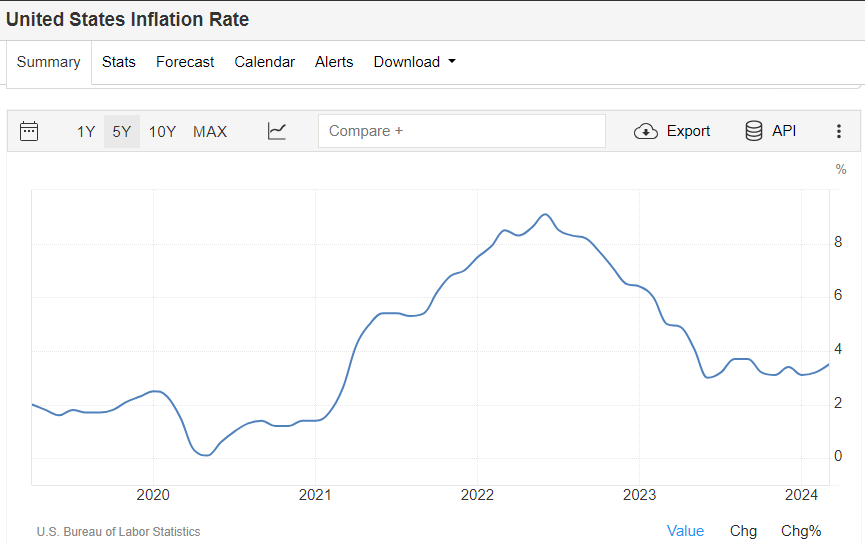Go Here to Read this Fast! NYT Strands: answers for Thursday, April 11
Originally appeared here:
NYT Strands: answers for Thursday, April 11
Go Here to Read this Fast! NYT Strands: answers for Thursday, April 11
Originally appeared here:
NYT Strands: answers for Thursday, April 11
Bitcoin’s price hike has pushed spot trading volume to multi-year highs
Market has seen an influx of new investors this year too
Bitcoin’s [BTC] price rally, which began in October 2023,
The post Bitcoin: How ‘new money’ helped BTC hit its 2021 highs again appeared first on AMBCrypto.
How many new Web3 solutions have you encountered recently? What was their value proposition? Most likely it was transaction scalability, fee reduction, speed optimization, or a new token for yet another payment system. It almost seems that the blockchain industry is stuck in a Groundhog Day of exclusively solving a single task: transferring currency from […]
The post Enough altcoins: Let’s integrate blockchain into the real economy appeared first on CryptoSlate.
Go here to Read this Fast! Enough altcoins: Let’s integrate blockchain into the real economy
Originally appeared here:
Enough altcoins: Let’s integrate blockchain into the real economy



A series of blog posts to share our perspectives on how to evaluate and improve your GenAI application pipelines
(written by Pasquale Antonante and Yi Zhang at Relari.ai)
The world of LLM app development is always on the move — new tricks, models, and apps pop up every week. As tech gets better, what users expect keeps ramping up. Staying ahead in this game is key to making sure it’s the one users keep coming back to.
The problem now becomes: how do you measure performance improvements? When you’re fiddling with prompts, tweaking the temperature, or switching up models, do you ever pause and think, “Will my users actually like this more?
In this post, we’ll walk through how in-app user feedback from earlier deployments (or internal human evaluation) can be instrumental in quickly shaping future versions of a product. We’ll discuss the limitations of traditional feedback mechanisms and introduce a new technique that allows AI developers to use feedback data directly in offline testing and iterations (before a new deployment), making the development cycle more adaptable and responsive to user preferences.
When developing LLM-based applications, we are often faced with a particular problem we want to address, e.g., a specific type of question has a low accuracy. As we experiment with tweaks in prompts, parameters, architecture, etc., we want to evaluate performance of the new pipeline, in particular whether users will like the new version(s) of your AI application. The most straightforward way is to A/B test each change with the end users and collect their feedback data such as thumbs up / down, score rating, or written comments, but practically it is challenging for a few reasons:
In the next section, we’ll introduce a novel approach that we’ve deployed to multiple customers to help them make the most out of their user feedback data in offline development.
In response to these challenges in collecting user feedback, we have developed a novel approach to simulate user feedback using a small sample of user (or internally labeled) feedback data. Specifically, we use metric ensembling and conformal prediction to learn user preferences and use them offline during the development phase. At its core, we learn how users weigh different criteria (e.g., tone, conciseness, etc) and leverage conformal prediction to provide predictions to quantify confidence. This method drastically accelerates LLM app development by providing a way to anticipate how users might react to new features or changes before they are fully implemented.
To evaluate its effectiveness, we compared this approach with the more conventional one of using a single LLM call that assesses different aspects of the response to make a judgment. To compare the two alternatives (the proposed approach vs. the single LLM call), we conducted an experiment using the Unified-Feedback dataset. We generated many potential …..We used Kendall’s tau, a measure of rank correlation, to compare the rankings produced by our user feedback simulation and the single LLM call approach against the ground truth established by human evaluations. This analysis allows us to assess not only the degree of agreement, but also the order of preference that each method predicts compared to the human rankings.
Our experiment revealed that the user feedback simulation has a correlation of 93% that significantly exceeded that of the single LLM call approach, which attains roughly 70% correlation. This indicates that, in terms of ranking , the simulated user feedback simulation provides a closer approximation to human judgment.

The reason why the simulated user feedback performs better is twofold:
While single LLM calls can identify major improvements in the pipeline, they fall short of detecting the more frequent, minor enhancements critical in mature pipelines. Simulated user feedback, however, exhibits a high correlation with human judgment, enabling the detection of these incremental advances.
As a side note, while we could have used the data to fine-tune an LLM, this has the typical drawback of requiring more data and not being as interpretable.
In the next section, we will walk through an example on how to create your simulated user feedback.
In this section we will show how we can use the open-source library continuous-eval to create simulated user feedback.
Consider a Q&A chatbot application. After deployment, users begin rating responses with thumbs up or down, indicating a need for performance enhancement. For this example we will use the example named correctness in continuous-eval:
dataset = Dataset(example_data_downloader("correctness"))
# Samples are annotated with "correct", "incorrect" or "refuse-to-answer"
# We remove the samples where the LLL refused to answer (i.e., said "I don't know")
dataset.filter(lambda x: x["annotation"] != "refuse-to-answer")
dataset.sample(300) # Only for this example: randomly sample 300 examples
As we mentioned, we want to create some custom criteria. We leverage the LLMBasedCustomMetric class to define the Tone and Conciseness metrics. To do so we need to define the metric and provide a scoring rubric.
For the tone:
tone = LLMBasedCustomMetric(
name="Tone",
definition="The Tone/Content Issues metric evaluates the appropriateness and accuracy of the tone and content in responses to specific questions. It focuses on ensuring that the tone is professional and suitable for the context, and that the content accurately addresses the question without unnecessary deviations or inaccuracies. This metric is crucial for maintaining a professional image and ensuring clear, direct communication.",
scoring_rubric="""Use the following rubric to assign a score to the answer based on its tone:
- Score 1: The response is inappropriate or inaccurate, with a tone that is either too informal, overly strong, or not suited to the professional context. The content may be irrelevant, incorrect, or fail to directly address the question posed.
- Score 2: The response is mostly appropriate and accurate but may contain minor tone or content issues. The tone is generally professional but may slip into informality or unnecessary strength in places. The content addresses the question but may include minor inaccuracies or unnecessary details.
- Score 3: The response is appropriate and accurate, with a tone that is professional and suited to the context. The content directly and correctly addresses the question without unnecessary deviations or inaccuracies.""",
scoring_function=ScoringFunctions.Numeric(min_val=1, max_val=3),
model_parameters={"temperature": 0},
)
while for conciseness:
conciseness = LLMBasedCustomMetric(
name="Conciseness",
definition="Conciseness in communication refers to the expression of ideas in a clear and straightforward manner, using the fewest possible words without sacrificing clarity or completeness of information. It involves eliminating redundancy, verbosity, and unnecessary details, focusing instead on delivering the essential message efficiently. ",
scoring_rubric="""Use the following rubric to assign a score to the answer based on its conciseness:
- Score 1: The answer is overly verbose, containing a significant amount of unnecessary information, repetition, or redundant expressions that do not contribute to the understanding of the topic.
- Score 2: The answer includes some unnecessary details or slightly repetitive information, but the excess does not severely hinder understanding.
- Score 3: The answer is clear, direct, and to the point, with no unnecessary words, details, or repetition.""",
scoring_function=ScoringFunctions.Numeric(min_val=1, max_val=3),
model_parameters={"temperature": 0},
)
We use Tone and Conciseness together with more standard metrics, in particular we will consider the
The next step is to put all the metrics together and specify what field of the dataset should be used to compute the metrics. To do that we can use the SingleModulePipeline
pipeline = SingleModulePipeline(
dataset=dataset,
eval=[
DeterministicAnswerCorrectness().use(
answer=dataset.answer,
ground_truth_answers=dataset.ground_truths,
),
LLMBasedAnswerCorrectness().use(
question=dataset.question,
answer=dataset.answer,
ground_truth_answers=dataset.ground_truths,
),
LLMBasedAnswerRelevance().use(
question=dataset.question, answer=dataset.answer
),
LLMBasedStyleConsistency().use(
answer=dataset.answer, ground_truth_answers=dataset.ground_truths
),
FleschKincaidReadability().use(answer=dataset.answer),
tone.use(
question=dataset.question,
answer=dataset.answer,
ground_truth_answers=dataset.ground_truths,
),
conciseness.use(
question=dataset.question,
answer=dataset.answer,
ground_truth_answers=dataset.ground_truths,
),
],
)
and run all the metrics using the EvaluationManager
eval_manager = EvaluationManager(pipeline)
# The dataset already contains the model output so we just set the evaluation results
eval_manager.evaluation.results = dataset.data
eval_manager.run_metrics() # Note: there is no progress bar, it might take a few minutes
The next step is to train simulated user feedback predictor
datasplit = DataSplit(
X=eval_manager.metrics.to_pandas(),
y=map(lambda x: 1 if x == "correct" else 0, dataset["annotation"]),
split_ratios=SplitRatios(train=0.6, test=0.2, calibration=0.2),
)
# We use the train and calibration sets to train the classifier
predictor = EnsembleMetric(training=datasplit.train, calibration=datasplit.calibration)
This simulated user feedback predictor is able to correctly predict the human feedback in the test split 96.67% of the time.
We can leverage the proposed approach to better understand what is important to the user. Below is the learned importance of every metric by the simulated user feedback predictor.

Looking at the plot, we see that Correctness (including token overlap, which is another measure for correctness) and Relevance to the question are the most important predictors of user preference. But the user also weighs tone and style consistency into the decision. At the same time, we can see that conciseness and readability are not as important. Reviewing this graph provides valuable insight into user preferences, giving a clear indication of what elements are essential and what can be adjusted if compromises need to be made.
Collecting user feedback is challenging, yet it is the most important information for developers of large language models (LLMs). By simulating user feedback during offline testing, we significantly reduces the time it takes for feedback to travel from the field back to developers, while maintaining positive user relationships.
In practice, our approach has proven to closely mirror actual human responses, outperforming traditional methods that rely on isolated LLM responses. This strategy allows for the incremental improvement of generative AI applications, fostering continuous refinement and greater congruence with what users expect.
—
Note: We will soon publish a research paper with more details on this methodology. Stay tuned!
How to make the most out of LLM production data: simulated user feedback was originally published in Towards Data Science on Medium, where people are continuing the conversation by highlighting and responding to this story.
Originally appeared here:
How to make the most out of LLM production data: simulated user feedback
Go Here to Read this Fast! How to make the most out of LLM production data: simulated user feedback


Some lessons I learned about quantifying qualitative thinking
Originally appeared here:
Why Human-Centred Approaches Lead to Better Algorithm Design
Go Here to Read this Fast! Why Human-Centred Approaches Lead to Better Algorithm Design



The primary two methods for getting rid of an app that just won’t go away come down to Force Quit and Activity Monitor. Both options will get the job done in almost any use case you may need to use either for and will go that extra step beyond simply quitting the app in question.
Go Here to Read this Fast! How to use Force Quit and Activity Monitor to close persistent apps
Originally appeared here:
How to use Force Quit and Activity Monitor to close persistent apps
Go Here to Read this Fast! Apple issues fix for ‘ghost touch’ problem on older Apple Watches
Originally appeared here:
Apple issues fix for ‘ghost touch’ problem on older Apple Watches
Blizzard is taking mid-match leaves on Overwatch 2 more seriously and is implementing harsher punishments when Season 10 arrives. People playing Unranked games won’t be able to join a queue for five minutes after leaving two of their last 20 games. And if they leave at least 10 out of the last 20, they’ll be suspended for 48 hours. Players probably want to be even more careful when it comes to leaving Competitive games, though, because doing so 10 times out of 20 will get them banned for the rest of the season. In its announcement, Blizzard said that while it’s aware not everyone abandons a game on purpose, these changes “should help curb those players who deliberately choose to leave a match.”
The developer is also making it easier for groups of friends to play together in Competitive mode, no matter their rank, by introducing “wide groups.” A wide group is defined by having players from a wide range of ranks, from Diamond to tiers up to five Skill Divisions lower. Blizzard admits that opting for the new queue option will mean longer wait times, since it has to pair a wide group with another wide group with similar ranks in order to be fair. But it’s hoping that the new feature will eliminate the need to use an alt account when playing with friends.
The company is also adding new features designed to help prevent abuse and harassment in-game. People will soon be able to add up to 10 players in their “Avoid as Teammate” list instead of just three. It’s also making it easy to report disruptive behavior by updating its reporting interface. Finally, Blizzard is blocking a player’s access to text or voice chat in their matches if they were found to have engaged in abusive behavior and have broken the company’s code of conduct. They can only get those privileges back if they spend time playing Overwatch 2 in their best behavior.
This article originally appeared on Engadget at https://www.engadget.com/overwatch-2-introduces-harsher-punishments-for-players-who-leave-mid-match-021319507.html?src=rss
Originally appeared here:
Overwatch 2 introduces harsher punishments for players who leave mid-match
MANA and AXS shared similar price trajectories over the last few weeks
Investigation of other metrics revealed who the crowds favoured more
A recent Santiment post on X (formerly Twitter) hi
The post MANA v. AXS – Identifying which project has the crowd’s backing now appeared first on AMBCrypto.


Quick Take The latest US inflation data has surprised analysts, with headline inflation year-over-year (YoY) coming in at 3.5% — 0.1% above forecasts. The development is significant considering the Federal Reserve’s most aggressive hiking cycle in decades, according to Statista, which aimed to tame the rampant inflation that the central bank initially claimed was transitory. […]
The post Bitcoin’s dual nature: shifting between risk-on and risk-off amid market turbulence appeared first on CryptoSlate.
Originally appeared here:
Bitcoin’s dual nature: shifting between risk-on and risk-off amid market turbulence